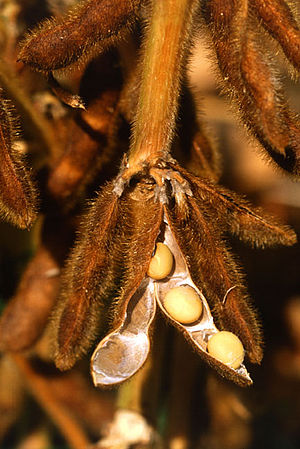What is It?
| Dried soybeans in pods. (Photo credit: Wikipedia) |
Generally, Eastern cultures will consume edamame in its whole bean form, either fresh, fermented or dried, instead of using the more aggressive processing methods found here in the US. We normally see dried soybeans in their light tan or pale yellow color, but mature soybeans can actually be found in a variety of different colors including black, brown, and even some shades of blue.
History
Soybeans have been cultivated in China for thousands of years, as early as the third and fourth centuries AD. Many countries in the world depend on soybeans and other legumes as key sources of dietary protein, but today more than 90 percent of the soybeans grown are used as an oilseed crop. This means the legumes are either dried, crushed and used as meal in animal feed, or pressed for their oils. Due to the recent increase in farming for oilseed crops, soybeans are becoming the ideal crop for genetic engineering with most of the agricultural patents for genetic modification coming from this crop.
Health Benefits
Edamame is incredibly rich in folate, vitamin K, magnesium, calcium, iron and fiber. So much so, that one study found adults in the US who completely replaced their meat and dairy intake with edamame would show increased levels in all of the vitamins and minerals listed above. Soybeans are also an important source of copper, manganese, phosphorus, potassium, riboflavin and, of course, the omega-3 fatty acids. And, as mentioned, edamame, or soybeans, are considered a protein staple by many.
Fun Fact
Edamame means "branch beans" in Japanese. The words edamame and soybeans are for the most part interchangeable. However, both the immature bean and the cooked dish is called edamame in Japan, whereas edamame is typically used in the US to describe only the dish. The bean, until recently, had always been called 'soy' in America. The cultivation and the use of soybeans has fascinated explorers, nutritionists, and even manufacturers, for centuries. Even Ford motor cars had a swing at using soy in their automobiles with plastic made from soybeans. (Although this may give one pause when considering eating them....)
| Japanese edamame, boiled and salted. (Photo credit: Wikipedia) |
Cooked green soybeans will generally keep fresh in the refrigerator for about three days if placed in a airtight container, while fresh should be stored in the refrigerator and eaten within two days. Frozen edamame will keep fresh for three months. My favorite way to eat fresh edamame is to boil for about 10 minutes, then drain well and sprinkle with coarse salt. Strip the beans from the pods with your teeth, and discard the pods (they make great compost fodder).
Whether you call them edamame or soy, the health benefits may be worth exploring. While there is some debate about the health of eating large quantities of processed soy, fresh soybeans contain more health benefits and are an easy and tasty way to add a bit of variety to your diet. Certainly the taste and versatility has earned this food item a place in our life, and in the world's history.



No comments:
Post a Comment
We welcome comments and suggestions!